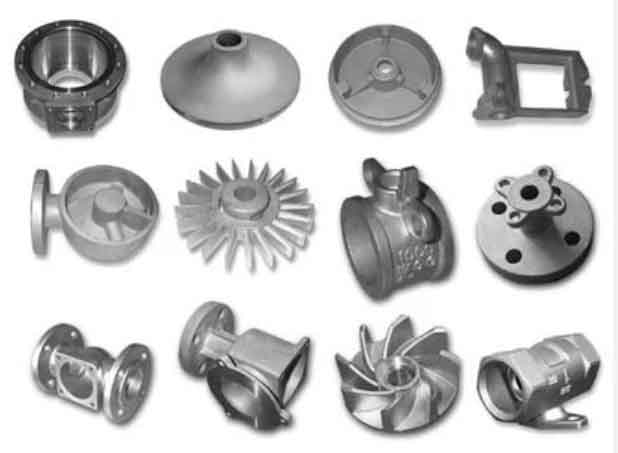
The strategic application of chills remains critical for controlling solidification patterns in ductile iron casting, particularly for high-grade components requiring superior mechanical properties. This paper systematically examines chill implementation strategies through thermodynamic analysis and industrial case studies.
1. Chill Material Selection Matrix
Table 1 compares thermal properties of common chill materials:
| Material | Thermal Conductivity (W/m·K) | Heat Capacity (J/kg·K) | Reusability |
|---|---|---|---|
| Gray Iron | 46-52 | 460 | 5-8 cycles |
| Carbon Steel | 43-48 | 502 | 10-15 cycles |
| Graphite | 80-150 | 710 | 20+ cycles |
| Chromite Sand | 2-3 | 920 | Single use |
The chill efficiency can be modeled using Fourier’s Law of heat conduction:
$$ q = -k \nabla T $$
Where q represents heat flux (W/m²), k thermal conductivity (W/m·K), and ∇T temperature gradient (K/m).
2. Solidification Dynamics with Chills
Chills modify the solidification sequence by creating directional heat extraction. The modified Chvorinov’s rule for chill-affected regions:
$$ t_f = B \left( \frac{V}{A} \right)^n $$
Where tf is solidification time, B mold constant, V/A volume-surface area ratio, and n chill influence factor (1.1-1.5 for ductile iron casting).
3. Thermal Gradient Optimization
Effective chill placement creates optimal thermal gradients (ΔT) between adjacent sections:
$$ \Delta T_{critical} = \frac{L}{\alpha c_p} $$
Where L is latent heat (260-290 kJ/kg for ductile iron), α thermal diffusivity, and cp specific heat capacity.
| Parameter | Gray Iron Chill | Graphite Chill |
|---|---|---|
| Initial Cooling Rate (°C/s) | 8-12 | 15-22 |
| Interfacial Heat Transfer Coefficient (W/m²K) | 500-800 | 1200-1800 |
| Effective Depth (mm) | 25-40 | 40-60 |
4. Chill Geometry Optimization
The chill effectiveness factor (CEF) can be expressed as:
$$ CEF = \frac{k_{chill} \cdot A_{contact}}{k_{mold} \cdot V_{chill}^{0.5}} $$
Where:
kchill = chill thermal conductivity
Acontact = chill-casting interface area
kmold = mold material conductivity
Vchill = chill volume
5. Case Study: Flange Junction Solidification
For a 50mm thick flange in ductile iron casting (EN-GJS-500-7), chill implementation reduced shrinkage porosity from 12.3% to 0.8%:
| Condition | Solidification Time (min) | Critical Gradient (°C/mm) | Shrinkage Volume (%) |
|---|---|---|---|
| No Chill | 28.4 | 0.85 | 12.3 |
| Gray Iron Chill | 19.7 | 1.42 | 3.1 |
| Graphite Chill | 14.2 | 2.15 | 0.8 |
6. Multi-Stage Chill Cooling Model
The transient heat transfer during ductile iron casting solidification can be modeled as:
$$ \rho c_p \frac{\partial T}{\partial t} = \nabla \cdot (k \nabla T) + Q_{latent} $$
Where Qlatent represents latent heat release during austenite-graphite transformation, critical for predicting chill effectiveness in nodular iron solidification.
7. Chill Surface Preparation Protocol
Optimal surface roughness parameters for chill-casting interface:
| Chill Type | Ra (μm) | Coating Thickness (mm) |
|---|---|---|
| Metallic Chills | 6.3-12.5 | 0.1-0.3 |
| Graphite Chills | 3.2-6.3 | 0.05-0.15 |
The interfacial heat transfer coefficient (h) follows the relationship:
$$ h = 85 + 120(1 – e^{-0.023P}) $$
Where P is contact pressure (kPa) between chill and mold.
8. Computational Process Optimization
Modern simulation techniques enable chill performance prediction through dimensionless analysis:
$$ Nu = C Re^m Pr^n $$
Where Nusselt number (Nu) characterizes convective heat transfer, Reynolds number (Re) flow conditions, and Prandtl number (Pr) material properties.
9. Advanced Chill Configurations
Recent developments in ductile iron casting include:
- Graded conductivity chills
- Active cooling chills with internal channels
- Phase-change material (PCM) augmented chills
The thermal effectiveness of PCM-enhanced chills can be modeled as:
$$ Q_{total} = Q_{sens} + Q_{latent} = m[c_p \Delta T + L_f] $$
Where m is PCM mass and Lf latent heat of fusion.
10. Future Development Directions
Emerging trends in chill technology for ductile iron casting include:
- Additively manufactured conformal chills
- Smart chills with embedded sensors
- Nanocomposite chill materials
The continued advancement of chill applications in ductile iron casting demonstrates their essential role in achieving high-integrity cast components through controlled solidification dynamics. Proper chill selection and implementation remain critical for optimizing mechanical properties while minimizing production costs in modern foundry practice.
